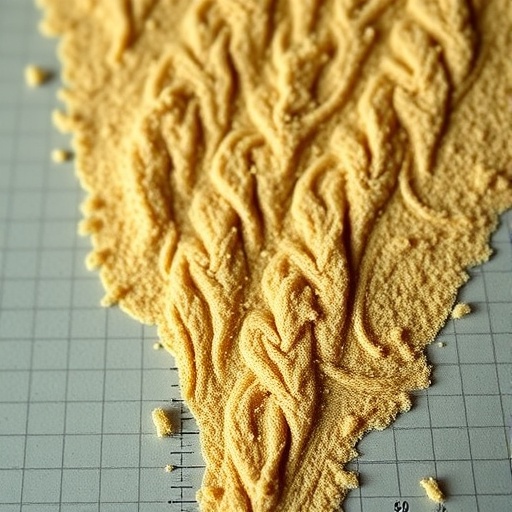
In the vast world of microbiology, yeast stands as a cornerstone of human culture and industry, having played a pivotal role in baking bread, fermenting beer, and crafting wine for millennia. Yet recent research from the University of Georgia reveals a surprising new dimension to this unassuming microbe: its population structure serves as a living record of human migration and environmental interaction. This cutting-edge study delves deep into the genetic makeup of wild and domesticated strains of baker’s yeast (Saccharomyces cerevisiae), unraveling a fascinating narrative that stretches back thousands of years and crosses continents.
Yeast domestication dates back at least 9,000 years, with humans harnessing its natural fermentation abilities to cultivate food and beverages. Typically associated with human-controlled processes, yeast also thrives in wild populations on tree bark and in forest ecosystems, where it exists independently of human influence. However, the genetic relationships between these wild yeast strains and those cultivated in human settlements have remained largely unexplored—until now. The University of Georgia’s team set out to characterize these populations on both sides of the Atlantic, using comprehensive genetic sequencing data harvested from environmental samples.
Their approach involved carefully collecting samples from a variety of tree barks, primarily across the southeastern United States, including sites remarkably close to academic campuses. By isolating yeast cells and cultivating them under laboratory conditions mimicking natural fermentation, researchers extracted DNA and applied advanced genomic analysis techniques. These analyses revealed complex population structures, with clear subpopulations within continents and intriguing overlaps between wild and domesticated groups. The results challenged previous assumptions that wild yeast populations exist in complete isolation from human activity, suggesting instead a more nuanced relationship shaped by millennia of interaction.
Intriguingly, the genetic divergence observed among yeast populations appeared to trace back to the last Ice Age, approximately 20,000 years ago. This period coincided with critical moments in human prehistory, such as the advent of agriculture and the spread of early farming communities across Europe and the Americas. These findings suggest that human migration and changing land-use patterns during and after glacial periods may have influenced both the distribution and evolution of yeast populations. Such a linkage underscores the bidirectional impact between humans and microorganisms in shaping ecological niches and evolutionary trajectories.
Further deepening the mystery, the study revealed striking genetic similarities between wild yeast populations native to the southern United States and those found in southern European winemaking regions. This pattern appears to stem from historical events dating back to the 19th century, namely the Great French Wine Blight—a devastating viticultural crisis triggered by the accidental introduction of a North American insect pest that ravaged European vineyards. To salvage the industry, European grapevines were grafted onto resistant North American rootstock, inadvertently transferring associated yeast populations across the Atlantic. This unintentional microbial migration underlines how human agricultural practices can have unforeseen consequences on microbial biodiversity.
The implications of this research extend beyond academic curiosity, shedding light on the pervasive and often unrecognized ways humans influence microbial ecosystems. The researchers caution that modern human activity, with its accelerated global trade and environmental alteration, is likely reshaping microbial populations even more rapidly and profoundly than in the past. Yeast, as a model organism, serves as a sensitive indicator of these unseen transformations, highlighting the delicate balance between wild and domesticated organisms in our shared environment.
This new understanding compels a reevaluation of microbial ecology in the Anthropocene, where anthropogenic forces act as major drivers of biodiversity, often with unpredictable outcomes. The UGA team’s work stands as a reminder that to truly comprehend human history and environmental change, one must look beyond the obvious and consider the microscopic footprints etched into the genomes of the species inhabiting our planet.
Moreover, the study’s methodology provides a blueprint for future research aiming to untangle the complex web of interactions among humans, microbes, and ecosystems. By leveraging publicly available genomic databases alongside fresh environmental sampling, the researchers exemplified integrative science capable of bridging history, ecology, and genetics.
These insights also highlight the importance of preserving natural habitats, where wild microbial populations continue to evolve outside of direct human control. Loss of such environments risks eradicating valuable biological diversity and potentially disrupting evolutionary dynamics critical to the resilience of microbial communities globally.
Ultimately, the research presents yeast not merely as a tool for food production but as a living archive of human migration and environmental history. Its genetic signatures encode stories of ancient climate shifts, cultural exchanges, and unintended consequences of human innovation, offering a profound new perspective on the interconnectedness of life on Earth.
Published in Molecular Ecology on April 4, 2025, and co-authored by Eduardo Scopel and Audrey Ward, the study opens avenues for further investigation into how other microorganisms might similarly reflect and influence human history. It calls attention to the invisible majority of life that quietly shapes our planet, urging both scientists and the general public to recognize the significance of microbial footprints in the narrative of humanity.
Subject of Research: Population genetics and migration patterns of wild and domesticated baker’s yeast (Saccharomyces cerevisiae) as influenced by human activity.
Article Title: Footprints of Human Migration in the Population Structure of Wild Baker’s Yeast
News Publication Date: 4-Apr-2025
Web References:
Research article in Molecular Ecology
References:
Bensasson, D., Peña, J., Scopel, E., Ward, A. (2025). Footprints of Human Migration in the Population Structure of Wild Baker’s Yeast. Molecular Ecology. DOI: 10.1111/mec.17669
Keywords: Human migration, Wines, Ancient DNA, Natural history
Tags: baker’s yeast domestication historyecological role of wild yeastenvironmental interaction of yeastgenetic sequencing of yeast strainshistorical significance of Saccharomyces cerevisiaehuman migration patternsinterdisciplinary study of yeast and migrationmicrobiology and human culturewild versus domesticated yeast populationsyeast and human civilization developmentyeast in food and beverage fermentationyeast population structure research





